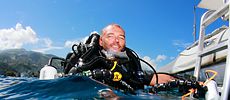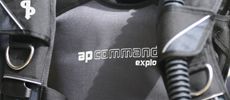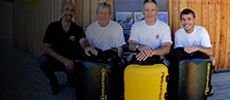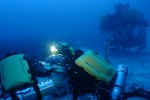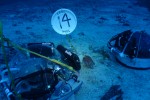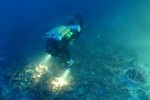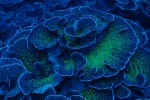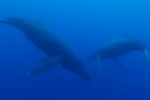This is really cutting edge stuff, with us doing experiments that no one has been able to attempt in these depths before, made possible by the joint efforts of both a sub and our CCR team.
Aloha, Dave
David F. Pence MS,
UH Diving Safety Officer
University of Hawaii – EHSO
Members of our dive team, consisting of Christina Bradley, Ken Longenecker, Dave Pence and myself, were all filled with a mixture of anxiety and excitement as we began our day at 5am to load our dive gear into the truck. It was exciting because it was the first time that any of us would attempt a deep rebreather dive in coordination with one of HURL’s Pisces submersibles. But we were nervous because this first dive was also going to be the most complicated one of the entire project.
The plan was for the submersible to scout the reef in search of a spot with rich Leptoseris coral beds adjacent to a sand patch, place a 20-inch diameter acrylic dome in the sand near the coral, and send up a marker float with a line attached to an anchor to serve as a guide for the divers to descend. The divers, bringing a second acrylic dome with them, would gather a series of eight small coral heads (four for each dome), remove a small sample from each piece of coral, and set the domes up to begin the experiment. After starting the experiment, the submersible would return several hours later to pick up the small samples after being treated.
The purpose of the experiment was to try to determine how much corals at this depth feed directly on plankton, vs. via the photosynthetic zooxanthellae (algae) in their tissues. One dome was clear, allowing sunlight in; and the other was blackened, to simulate night. Both were equipped with special battery-operated pumps to gather data on the water, and both had a syringe full of rotifers (planktonic organisms) that were ‘tagged’ with a special chemical marker, to allow later analysis of the corals.
This was a perfect experiment to coordinate the submersible and a team of divers, because the submersible had the time necessary to scout out the bottom, select the right location, and return hours later to collect the first samples; and also could carry one of the domes and the marker buoy and anchor. The divers were better able to gather a set of corals, take samples, place them under the domes, and start the experiment. Christina (known to her friends as ‘CJ’) was probably the most nervous before the dive, because it was her experiment, and we had only one chance to get it right. This experiment needed to be started at the beginning of the project to allow time over the course of the next 11 days to continue to take samples from the treated corals. If we didn’t get it right this time, it would have been a long time before we had another chance.
After a bit of searching, they finally found the perfect spot, at a depth of 290 feet (88 meters). As we donned our rebreathers and completed the necessary pre-dive checks, the submersible released the buoy to mark the spot, and down we went. Each of us had a specific task to perform, which we had discussed many times in the days leading up to this dive. Because of the training and experience of both the submersible team (pilot Terry Kerby, and researchers Brian Popp and Andrea Grottoli), as well as our rebreather dive team and support crew (including safety diver Holly Bolick and the boat captain and crew for B&B Scuba on Maui), I am delighted to report that the mission went off almost perfectly. We had allowed ourselves 20 minutes to complete the complex task, and it was done in 19 minutes — a full minute to spare! The two-and-a-half-hour decompression was long, but we were all very glad that the mission was accomplished successfully.
Aloha,
Rich
Richard Pyle
University of Hawaii




